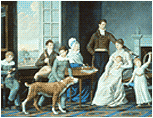 |
 |
William Berczy
Canadian 1744 - 1813
The Woolsey Family 1809
oil on canvas |
 |
| Early donations from Canadian artists remain key works in a display which includes over 800 paintings, sculpture and decorative works ranging from 18 th century religious Québec sculpture to the avant-garde paintings of the 1960s. Installed in the spacious Canadian galleries (3,381 m2 of exhibition space) and arranged chronologically as well as regionally, they show the diversity of Canadian creativity, a presentation unique in scale, richness and quality.
The first four galleries in the Canadian collection focus on the art of Quebec and demonstrate the diversity of patronage from the paintings and sculptures by artists such as François Baillairgé (1759-1830) commissioned by the Roman Catholic Church, to an array of portraits that include William Berczy's (1744-1813) The Woolsey Family and Antoine Plamondon's (1804-1895) portrait of Soeur Ste. Alphonse. Adding to this variety, the landscapes and genre scenes by the Dutch born artist Cornelius Krieghoff (1815-1872), contrast with the dramatic history paintings by Québec's Joseph Legaré (1798-1855).
The roots of art in Upper Canada and the Maritimes are seen in the panoramic urban views of southwestern Ontario by Robert Whale (1805-1887), the forceful studies of Canada's native peoples by Paul Kane (1810-1871), the splendid portraits of Haligonians by Robert Field (1769-1817), and the dramatic storm-tossed frigates of John O'Brien (1831-1891). The unique painted Croscup room from Karsdale, Nova Scotia is a unique example of early Canadian decorative painting.
|
 |
 |
Marc-Aurèle de Foy Suzor-Coté
Canadian 1869 - 1937
Winter Landscape 1909
oil on canvas |
 |
| The National Gallery's support and purchases of paintings by Tom Thomson and the Group of Seven in the time of the group's inception has resulted in the most comprehensive collection of works by these renowned painters. Tom Thomson's The Jack Pine (1917, purchased 1918), A.Y. Jackson's The Red Maple (purchased in 1914, the year it was painted), Lawren Harris' North Shore Lake Superior (1926, purchased 1930) and J.E.H. MacDonald's The Solemn Land (1921 purchased 1921) are all key works in the comprehensive display at the Gallery. Mural panels, painted in 1915 by Tom Thomson, Arthur Lismer and J.E.H. MacDonald for Dr. James MacCallum's cottage at Go Home Bay on Georgian Bay and donated to the Gallery by Mr. and Mrs. Henry Jackman in 1969, is installed along with these works. Dr. MacCallum, an important early patron of these artists, bequeathed in 1943 his important collection of 134 paintings by these and other Canadian artists to the National Gallery of Canada.
Besides MacCallum, many other collectors and friends of artists have made notable contributions to the Gallery's collection. Vincent Massey, a former Governor General of Canada, bequeathed his important collection of Canadian art to the Gallery in 1968, including the moving portrait Ludivine by Edwin Holgate (1892-1977), Indian Hut, Queen Charlotte Islands by Emily Carr (1871-1945), Tadoussac by Charles Comfort (1900-1994) and Landscape Hochelaga by Marc-Aurèle Fortin (1888-1970). A broad selection (approximately 6,000) of the finest examples of Canadian silver, ranging from the 18th to the 20th century come from the Henry Birks Collection of Canadian Silver, donated to the National Gallery in 1979 by Henry Birks and Sons, Montréal, and Douglas Duncan, an important figure in the Toronto art scene for almost 30 years, gave the Gallery, through his family, over 634 works of art including the most comprehensive selection of works by David Milne (1882-1953).
All the regions of Canada are represented in the later galleries: E.J. Hughes (b.1913) from British Columbia; Jean-Paul Lemieux (b.1904) from Quebec; and Alex Colville (b.1920) from Nova Scotia. Also represented are works by members of Painters Eleven from Toronto, Plasticiens from Montréal, and Regina Five from Saskatchewan.
The Canadian Galleries are complemented by four theme rooms designed to explore certain aspects of Canadian art history. The themes range in subject from a study of Canadian silver to Abstract painters in their own words'. The themes are introduced through a selection of works of art, photographic documentation, texts, computers as well as audio and video productions.
The creativity of Canadians reaches across this land and the best is on display in the National Gallery of Canada.
|
| Rideau Street convent chapel |
 |
| This chapel, previously part of the Convent of Our Lady of the Sacred Heart (a girls school in Ottawa administered by Sisters of Charity), was almost destroyed some years ago. Dismantled in 1972 and kept in storage until1987, the soaring fan vaults, cast-iron columns, three altars and altar screen as well as the splendid windows make up the only known chapel of its kind in North America. As the only 19th century ecclesiastical interior of its kind, it is a priceless element of our Canadian Heritage. The complete interior of the chapel, designed in 1887 by diocesan architect Canon Georges Bouillon, has been reconstructed and dramatically presented in the centre of the Canadian galleries. |
Curator
Charles Hill, Curator Canadian Art
For access to high-quality reproduction, artists' biographies, video interviews and information on the entire collection of the National Gallery of Canada visit http://cybermuse.gallery.ca/
|

